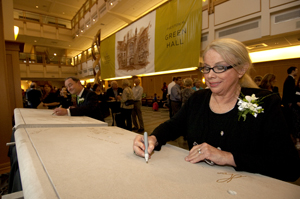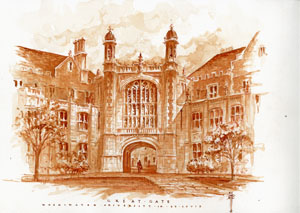A groundbreaking ceremony for a new School of Engineering & Applied Science building on the Danforth Campus at Washington University in St. Louis was held Friday, April 30, in Uncas A. Whitaker Hall.
The building, which will be named in honor of the late Preston M. Green, a WUSTL alumnus and benefactor, will turn the corner at Skinker Boulevard and Forest Park Parkway, connecting on its western edge to the recently completed Stephen F. and Camilla T. Brauer Hall.
In 2006, Chancellor Mark S. Wrighton announced an $8 million commitment from Green to support the School of Engineering & Applied Science and its Department of Electrical & Systems Engineering, which was named in Green’s honor.
Nancy Green, Preston’s widow, lives in St. Louis and serves on the advisory board for the Preston M. Green Charitable Foundation. In 2010, the foundation committed an additional $5 million to support the construction of the Preston M. Green Hall.
“It is a privilege to have the opportunity to honor our distinguished alumnus, Preston M. Green,” Chancellor Mark S. Wrighton said at the groundbreaking. “The new building named for him will accelerate the pace of progress in our School of Engineering & Applied Science.
“The new spaces for research and education will be a lasting tribute to a longtime friend and benefactor,” Wrighton said.
Participating in the ceremony were Wrighton; Salvatore P. Sutera, PhD, the outgoing dean of the School of Engineering & Applied Science; Ralph S. Quatrano, PhD, the incoming dean and the Spencer T. Olin Professor; Justin Ruths, a doctoral candidate in the Preston M. Green Department of Electrical & Systems Engineering; Stephen F. Brauer, chairman of the Board of Trustees; and Nancy Green.
“Preston M. Green Hall will provide the School of Engineering & Applied Science with state-of-the-art research and instructional facilities that will not only enhance our research efforts but will also be a strong, attractive force for recruiting and retaining the very best faculty and students,” Quatrano said.
Born in St. Louis in 1915, Preston M. Green earned a bachelor of science degree in electrical engineering from Washington University in 1936. After graduation, Green worked in a local factory until he joined Southwest Steel Supply Co. in 1950 as vice president of purchasing and production.
Green became president in 1955 and chairman of the board in 1957. During his career at Southwest Steel Supply Co., Green was responsible for adding a second manufacturing plant in Madison, Ill., and growing his company into the leading processor of steel throughout the Midwest.
Green designed most of the equipment used by Southwest Steel Supply Co., and he was acknowledged for creating more efficient processing procedures. Green was recognized nationally for his leadership and vision within the steel industry, including receiving the Steel Distributor of the Year award in 1986 from the Association of Steel Distributors.
In 1990, Green sold Southwest Steel to Hanwa American, a subsidiary of the Hanwa Corporation of Japan. Green died in 2003, but his legacy continues today through his many contributions, both professional and philanthropic.
“I wish Preston could be here today to see his dream become reality,” Nancy Green said. “He was a strong believer in innovation and forward thinking. Preston would have been so very proud of the School of Engineering & Applied Science and the facilities that it is providing for its students.”

Green Hall is the next phase of the new state-of-the-art complex of engineering buildings at the northeast corner of the Danforth Campus.
When it is completed in December 2011, the 70,000-square-foot building will provide additional research facilities that are critical to the continued development of the school’s strategic plan, including additional space for the Preston M. Green Department of Electrical & Systems Engineering.
It also will be home to the International Center for Advanced Renewable Energy and Sustainability (I-CARES).
Directed by Himadri Pakrasi, PhD, the George William and Irene Koechig Freiberg Professor of Biology in Arts & Sciences and professor of energy in the School of Engineering & Applied Science, I-CARES is a major initiative that encourages and coordinates university-wide and external collaborative research into biofuels and other alternative energy applications.
“Green Hall is a fitting name for a building that will be the permanent home of I-CARES,” Pakrasi said. “And the building’s location at the entrance of the Danforth Campus will make a powerful statement about the university’s commitment to research and education in renewable energy and sustainability.”
Green Hall will connect with Brauer Hall on all three levels of its west facade. It will present a seamless quality to those within the two structures to create an extraordinary physical presence on the northeast side of the Danforth Campus.
On the diagonal at the corner of the two wings of the building, there will be an impressive gateway similar to the one at the top of the steps leading to Brookings Hall.

The two wings of the Preston M. Green Hall will be connected by a gate that will lead to the intersection of Skinker Boulevard and Forest Park Parkway. Download high-res image.
The architectural firm RMJM, which also designed Brauer Hall, was chosen because it specializes in laboratory design and historic preservation. The construction firm is Clayco, also chosen to build Brauer Hall.
The new building will share the Collegiate Gothic style characteristic of the campus.
All of WUSTL’s recent construction projects have been built with environmental sustainability in mind, and this building also is being designed according to LEED specifications for a Gold rating.
LEED, the acronym for Leadership in Energy and Environmental Design, is a nationally accepted rating system for the design, construction and operation of buildings that use its specifications for achieving environmental sustainability.